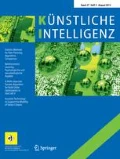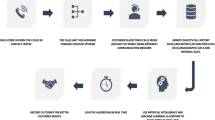Abstract
The Semantic Web has matured from a vision and research area of a few AI specialists to an important technology being used in a large number of research and a few practice projects. Most building blocks of the Semantic Web stack are filled with concrete technologies and W3C standards, but there are still enough areas for research. However, even with existing technologies, the potential of semantic applications within corporations is not yet fully harnessed as the adoption of Semantic Web technologies lacks behind other technologies like NoSQL databases or Web 2.0 technologies. This paper reviews the state of the art of Semantic Web technologies, discusses important terms and developments as well as currently active research streams. It further analyses available tools and applications with a focus on corporate scenarios and open source software and concludes with the suggestion of an architecture for a corporate semantic intranet.



Similar content being viewed by others
Notes
in SWRL: hasParent(?x, ?y), hasSibling(?y, ?z), hasSex(?z, MaleSex) -> hasUncle(?x, ?z).
hasParent, hasBrother => hasUncle.
http://www.w3.org/wiki/LargeTripleStores, last access 2015-09-24.
http://bit.ly/1NP0Lla, last access 2015-09-24.
http://bit.ly/1PYJE51, last access 2015-09-24.
http://bit.ly/1OrJ51K, last access 2015-09-24.
https://www.openhub.net/p/smw, last access 2015-09-24.
http://bit.ly/1NOUdD7, last access 2015-09-24.
http://bit.ly/21fyHBe, last download 2015-09-24.
References
Moore M (2012) The semantic web: an introduction for information professionals. The Indexer 30:38–43
Rattanasawad T, Saikaew KR, Buranarach M, Supnithi T (2013) A review and comparison of rule languages and rule-based inference engines for the Semantic Web. In: International computer science and engineering conference (ICSEC). IEEE, pp 1–6
Jaques Y, Anibaldi S, Celli F, Subirats-Coll I, Stellato A, Keizer J (2012) Proof and trust in the OpenAGRIS implementation. In: 2012 International conference on Dublin core and metadata applications. pp 33–37
Jacobi I, Kagal L, Khandelwal A (2011) Rule-based trust assessment on the semantic web. In: Bassiliades N, Governatori G, Paschke A (eds) Rule-based reasoning, programming, and applications. Springer, Berlin, pp 227–241
Nepal S, Paris C, Bouguettaya A (2013) Trusting the social web: issues and challenges. World Wide Web 18:1–7
Groth P, Moreau L (2013) PROV-overview. An overview of the PROV family of documents. W3C note. http://www.w3.org/TR/prov-overview/
Lampesberger H (2015) Technologies for web and cloud service interaction: a survey. Serv Oriented Comput Appl 10:1–40
Hogan A (2014) Linked data and the Semantic Web standards. In: Harth A, Hose K, Schenkel R (eds) Linked data management. CRC Press, Boca Raton
Auer S, Lehmann J, Ngomo A-CN, Zaveri A (2013) Introduction to linked data and its lifecycle on the web. In: Polleres A, d’Amato C, Arenas M et al (eds) Reasoning web. Semantic technologies for intelligent data access. Springer, Berlin, pp 1–90
Aquin MD, Motta E, Sabou M, Angeletou S, Gridinoc L, Lopez V, Guidi D (2008) Toward a new generation of semantic web applications. Intell Syst IEEE 23:20–28
Aghaei S, Nematbakhsh MA, Farsani HK (2012) Evolution of the world wide web: from web 1.0 TO web 4.0. Int J Web Semant Technol 3:1–10
Siadaty M, Jovanović J, Gašević D (2013) The social semantic web and workplace learning. In: Littlejohn A, Margaryan A (eds) Technology-Enhanced professional learning: processes, practices, and tools. Routledge, pp 132
Khalili A, Auer S (2013) WYSIWYM authoring of structured content based on Schema. org. In: Web information systems engineering–WISE 2013. Springer, pp 425–438
Jara AJ, Olivieri AC, Bocchi Y, Jung M, Kastner W, Skarmeta AF (2014) Semantic web of things: an analysis of the application semantics for the IoT moving towards the IoT convergence. Int J Web Grid Serv 10:244–272
Hasan S, Curry E, Banduk M, O’Riain S (2011) Toward situation awareness for the semantic sensor web: complex event processing with dynamic linked data enrichment. SSN 839:69–81
Möller R, Neuenstadt C, Özçep ÖL (2015) Stream-temporal querying with ontologies. In: 1st Workshop on high-level declarative stream processing (HIDEST’15). CEUR, Dresden, Germany, pp 42–55
Paschke A, Coskun G, Heese R, Luczak-Rosch M, Oldakowski R, Schafermeier R, Streibel O (2010) Corporate semantic web: towards the deployment of semantic technologies in enterprises. In: Du W, Ensan F (eds) Canadian semantic web: technologies and applications. Springer, New York, p 105
Ege B, Humm B, Reibold A (2015) Corporate semantic web wie semantische anwendungen in unternehmen nutzen stiften. Springer, New York
Google (2012) Introducing the knowledge graph: things, not strings. http://googleblog.blogspot.com/2012/05/introducing-knowledge-graph-things-not.html
Aron J (2011) How innovative is apple’s new voice assistant, siri? New Sci 212:24
Michel F, Montagnat J, Faron-Zucker C (2014) A survey of RDB to RDF translation approaches and tools. Research report hal-00903568
Kämpgen B, Harth A (2014) OLAP4LD–A framework for building analysis applications over governmental statistics. In: Presutti V, Blomqvist E, Troncy R, Sack H, Papadakis I, Tordai A (eds) The semantic web: ESWC 2014 satellite events. Springer, Berlin, pp 389–394
Ibragimov D, Hose K, Pedersen TB, Zimányi E (2015) Towards exploratory OLAP over linked open data—a case study. In: Castellanos M, Dayal U, Bach Pedersen T, Tatbul N (eds) Enabling real-time business intelligence—BIRTE 2013 and 2014 revised selected papers. Springer, Berlin, pp 114–132
Palacios V, Sanchez-Cuadrado S, Yadav D, Morato J, Dimou C (2013) Ontologies evaluation for a conceptual retrieval system of metadata schemes: case study. In: 6th International conference on contemporary computing (IC3). IEEE, pp 472–478
Manaf NAA, Bechhofer S, Stevens R (2012) The current state of SKOS vocabularies on the web. In: Simperl E, Cimiano P, Polleres A, Corcho O, Presutti V (eds) The semantic web: research and applications. Springer, Berlin, pp 270–284
Suominen O, Mader C (2014) Assessing and improving the quality of SKOS vocabularies. J Data Semant 3:47–73
Manning CD, Surdeanu M, Bauer J, Finkel J, Bethard SJ, McClosky D (2014) The stanford CoreNLP natural language processing toolkit. In: 52nd Annual meeting of the association for computational linguistics: system demonstrations. pp 55–60
Peinl R (2011) Unified information access. Inf Spektrum 34:594–597
Jain V, Singh M (2013) Ontology development and query retrieval using protégé tool. Int J Intell Syst Appl IJISA 5:67
Frischmuth P, Martin M, Tramp S, Riechert T, Auer S (2014) OntoWiki—an authoring, publication and visualization interface for the data web. Semantic Web J 6(3):215–240
Modoni GE, Sacco M, Terkaj W (2014) A survey of RDF store solutions. In: International conference on engineering, technology and innovation (ICE). IEEE, pp 1–7
Sankar S, Sayed A, Bani-Younis JA (2014) A schematic analysis on selective-RDF database stores. Int J Comput Appl 86:21–28
Mutharaju R, Hitzler P, Mateti P, Lécué F (2015) Distributed and scalable OWL EL reasoning. In: Gandon F, Sabou M, Sack H, d’Amato C, Cudré-Mauroux P, Zimmermann A (eds) The semantic web. Latest advances and new domains. Springer, Berlin, pp 88–103
Esteban-Gutiérrez M, Mihindukulasooriya N, Garcıa-Castro R (2014) LDP4j: a framework for the development of interoperable read-write linked data applications. In: 1st ISWC developers workshop. Riva del Garda, Italy
Behrendt W (2012) The interactive knowledge stack (IKS): A vision for the future of CMS. In: Maass W, Kowatsch T (eds) Semantic technologies in content management systems. Springer, Berlin, pp 75–90
Gangemi A (2013) A comparison of knowledge extraction tools for the semantic web. In: Cimiano P, Corcho O, Presutti V, Hollink L, Rudolph S (eds) The semantic web: semantics and big data. Springer, Berlin, pp 351–366
Heuss T, Humm B, Henninger C, Rippl T (2014) A comparison of NER tools wrt a domain-specific vocabulary. In: 10th International conference on semantic systems. ACM, pp 100–107
Tablan V, Bontcheva K, Roberts I, Cunningham H (2015) Mímir: an open-source semantic search framework for interactive information seeking and discovery. Web Semant Sci Serv Agents World Wide Web 30:52–68
Bast H, Bäurle F, Buchhold B, Haussmann E (2014) Semantic full-text search with broccoli. In: 37th International ACM SIGIR conference on research and development in information retrieval. ACM, pp 1265–1266
Van Nuffelen B, Janev V, Martin M, Mijovic V, Tramp S (2014) Supporting the linked data life cycle using an integrated tool stack. In: Auer S, Bryl V, Tramp S (eds) Linked open data–creating knowledge out of interlinked data. Springer, Berlin, pp 108–129
Gams E, Mitterdorfer D (2009) Semantische content management systeme. In: Blumauer A, Pellegrini T (eds) Social semantic web: web 2.0—was nun?. Springer, New York
Befa M, Kontopoulos E, Bassiliades N, Berberidis C, Vlahavas I (2010) Deploying a semantically-enabled content management system in a state university. In: Andersen KN, Francesconi E, Grönlund A, van Engers TM (eds) Electronic government and the information systems perspective. Springer, Berlin, pp 257–264
Ferrnandes J, Lourenço A (2014) Bringing named entity recognition on drupal content management system. In: 8th International conference on practical applications of computational biology and bioinformatics (PACBB 2014). Springer, pp 261–268
Arapov P, Buffa M, Ben Othmane A (2014) WikiNEXT: a wiki for exploiting the web of data. In: 29th Annual ACM symposium on applied computing. ACM, pp 727–734
Ell B, Simperl E, Wölger S, Kämpgen B, Hangl S, Vrandečić D, Siorpaes K (2011) Enterprise knowledge structures. In: Warren P, Davies J, Simperl E (eds) Context and semantics for knowledge management. Springer, Berlin, pp 29–59
Grimnes GA, Sauermann L, Bernardi A (2009) The personal knowledge workbench of the nepomuk semantic desktop. In: 6th European Semantic Web Conference (ESWC 2009), Heraklion, Crete, Greece
Schürmann T (2014) Baloo ersetzt nepomuk als semantische desktop-suche unter KDE. Linux-Mag
Witte R, Gitzinger T (2008) Semantic assistants–user-centric natural language processing services for desktop clients. In: Domingue J, Anutariya C (eds) The semantic web. Springer, Berlin, pp 360–374
Gitzinger T, Witte R (2008) Enhancing the OpenOffice.org word processor with natural language processing capabilities. Nat Lang Process Resour Algorithms Tools Authoring Aids, Workshop at LREC 2008, Marrakech Moroc
Sateli B, Witte R (2012) Natural language processing for MediaWiki: the semantic assistants approach. In: 8th International Symposium on Wikis and Open Collaboration (WikiSym 2012), Linz, Austria
Bakalov F, Sateli B, Witte R, Meurs M-J, König-Ries B (2012) Natural language processing for semantic assistance in web portals. In: 2012 IEEE sixth international conference on semantic computing (ICSC). IEEE, pp 67–74
Kyzirakos K, Karpathiotakis M, Koubarakis M (2012) Strabon: a semantic geospatial DBMS. In: 11th Intl Semantic Web Conf, Boston, MA, USA
Le Grange JJ, Lehmann J, Athanasiou S, Garcia-Rojas A, Giannopoulos G, Hladky D, Isele R, et al (2014) The GeoKnow generator: managing geospatial data in the linked data web. Presented at the linking geospatial data workshop
Dadzie A-S, Rowe M, Petrelli D (2014) Hide the stack: toward usable linked data. In: 8th Extended Semantic Web Conf (ESWC 2011), Heraklion, Crete, Greece
Huynh D, Karger DR, Quan D et al (2002) Haystack: a platform for creating, organizing and visualizing information using RDF. In: 11th World Wide Web Conf Semantic Web Workshop, Hawaii
Auer S, Doehring R, Dietzold S (2010) LESS—template-based syndication and presentation of linked data. In: 7th Extended semantic web conference (ESWC’10). Heraklion, Crete, Greece, pp 211–224
Dietzold S (2005) Generating RDF models from LDAP directories. In: Workshop on scripting for the semantic web (SFSW’05)
Cuzzocrea A, Song I-Y, Davis KC (2011) Analytics over large-scale multidimensional data: the big data revolution! In: Proceedings of the ACM 14th international workshop on data warehousing and OLAP. ACM, pp 101–104
Becker C (2013) Solr as an analytics platform. http://shutr.bz/1KNyQjG
Corcoglioniti F, Rospocher M, Cattoni R, Magnini B, Serafini L (2013) Interlinking unstructured and structured knowledge in an integrated framework. In: 7th International conference on semantic computing (ICSC’13). IEEE, pp 40–47
Author information
Authors and Affiliations
Corresponding author
Rights and permissions
About this article
Cite this article
Peinl, R. Semantic Web: State of the Art and Adoption in Corporations. Künstl Intell 30, 131–138 (2016). https://doi.org/10.1007/s13218-016-0425-0
Received:
Accepted:
Published:
Issue Date:
DOI: https://doi.org/10.1007/s13218-016-0425-0




